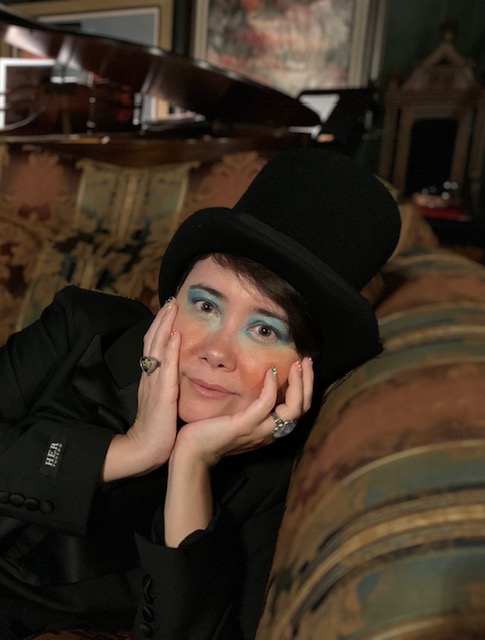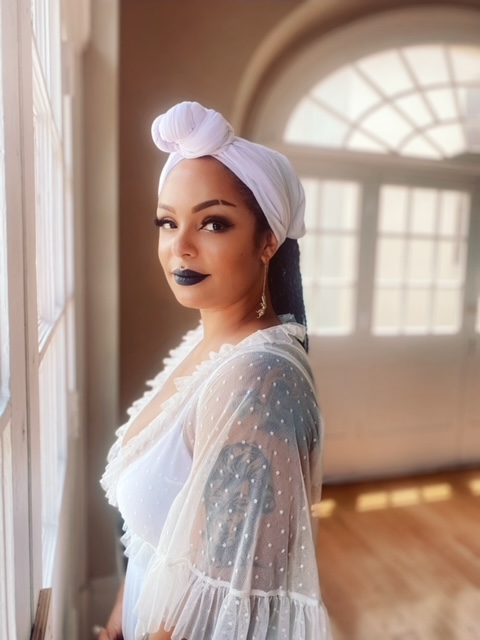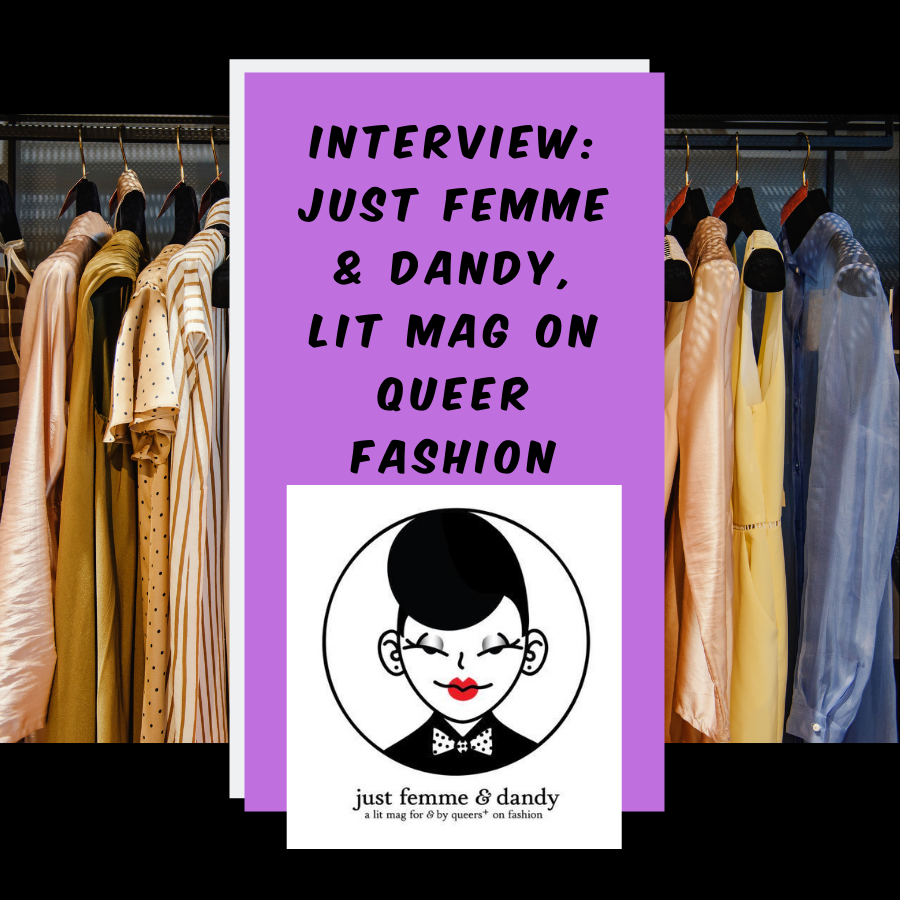just femme & dandy is a biannual literary & arts magazine for and by the LGBTQIA+ community on fashion that privileges underrepresented and marginalized writers and artists. They accept the following for submissions: poetry, fiction, nonfiction, comics, illustration, drag, dance, video, film, photography, tutorials, interviews, reviews, listicles, think pieces, commentaries, historical investigations, and others. Being an anti-racist, pro-Black space, the magazine prioritizes submissions from artists of color. And they pay! $50 USD per text-based submission and $150 USD per multimedia submission. I interviewed Addie Tsai, the founder & co-editor in chief, and Sarah Sheppeck, the co-editor in chief.
Rashmila Maiti: As we are a book club, what are you currently reading? Who are your favorite authors?
Addie Tsai: We are both reading the same book, White Magic by Elissa Washuta. And my favorites are James Baldwin, Marguerite Duras, and Judy Blume. Some of the writers (YA, fiction, non-fiction) that I am currently interested are in Emily X.R. Pan, Octavia Butler, Kiese Laymon, Mark Oshiro, and Alexander Chee.
Sarah Sheppeck: One of my favorite contemporary authors is N.K. Jemisin. I have always been impacted by children’s literature. So, growing up, I really liked Lewis Carroll, The Little Prince by Antoine de Saint-Exupéry, and the Chronicles of Narnia by C. S. Lewis. Now, I read a lot of adult fantasy and thrillers including books by Stephen Graham Jones. I read a lot to broaden my horizons.
RM: Why was the publication started? What was the idea behind the magazine?
AT: For close to a decade, I have been eagerly looking for a magazine like just femme & dandy that focused on writing but also included art. My earliest idea was a magazine that would include visual arts and also poetry, fiction, non-fiction, tutorials, hot takes, or critiques of the bullshit that was going on in the fashion industry, but centered on queer fashion and every type of identity under the LGBTQIA+ umbrella. I had never seen a space that encompassed everyone. For several years, I was paying attention and talking to people, and thinking that maybe this is something I should create because I didn’t see it anywhere. In December 2019, I published a folio with Anomaly where I have edited fiction for the past two years. Its managing editor, Sarah Clark, asked me if I was interested in curating a folio. The curation gave me an idea that this is something I am excited about: helping to create a space for others, and not necessarily always being the one with the creative works.
Then the pandemic happened, and I thought, what else are we going to do? Sarah and I had been acquainted for a few months at that point. I had a very clear instinct and intuition that they were the perfect person to work with on this because our aesthetics are different, so we were going to bring different ideas to the table and different parts of the community together. I asked Sarah on a whim, and they were immediately on board. We took our time finding the right people, keeping in mind that we couldn’t begin this project the way we might have before the pandemic. I feel like the inaugural issue came out when it was supposed to. The work is all very different and really complementary with each other.

SS: I was attracted to launching this project with Addie because there’s a difference between simply having any type of marginalized group represented and actually celebrating and elevating those marginalized people. And so, I saw an opportunity here where those communities can consistently participate in an ongoing discussion and exploration of what it means to fit into different gender identities and sexual orientations, and how race intersects with those things. I was happy that Addie trusted me to take that on.
RM: What have been some of the high points of running a literary magazine?
SS: The high point has been connecting with other writers and queer artists while creating the first issue. I met our entire editorial staff in 2020 and some amazing performers, poets, artists who have contributed to the first issue.
AT: It has been incredible to see this idea come to life. It’s really exciting to see this diverse community built between ourselves, the editors, and the world of art contributors. We’re are all part of this same universe. Even though we are dealing with complex issues, it’s really a space of joy and celebration, and a culmination of oneself. The energy and excitement of the work, now that we are out there, has been wonderful and such a gift, especially now. I think we can all use the joy and glitter as much as possible, even if it is within our houses.
RM: What are the biggest challenges that just femme & dandy is facing?
AT: Money. It’s really hard to start a journal from scratch and it was very important to us that we start as a paying market. I am really proud of the fact that we could do that and still survive. We were lucky to receive a tiny grant that I submitted to on a whim; Sarah and I were just starting to build the magazine. We used the grant to manage our operations and to pay our contributors. The funding is a lot of work, and our editorial staff is incredibly generous with their time and labor. They’re all volunteers, and we hope that will change in the near future. It’s a lot to manage as Sarah and I both have full-time jobs.
SS: I agree that funding is our biggest challenge, to be able to compensate all of our creators and editors fairly. Other challenges are the growing pains in terms of resources that we need to keep going. We built the website from scratch and figured out which platform to put the issue on, and now we are researching where to get our magazine printed at reasonable costs.the

RM: What advice would you give writers trying to publish with your magazine? Do you provide comments when you reject a submission?
SS: I think we provide pretty minimal comments when we return rejected submissions. Submissions go to individual section editors; some provide more feedback than others.
AT: I think we might do more of that in the future, but that’s not part of our standard practice now. We are also looking into something like Patreon for memberships for comments or feedback. For submitters to our magazine, we’d suggest thinking about how their work relates to queer fashion, and figure out how to make it publishable. One suggestion is to curate the number of photos you give us, be it in a photo-spread or a text with images, and to pick eight to ten that tell their story in the most evocative and clear way. Because we have the flip-through magazine that we plan to print, in addition to the website content, we don’t have the space to publish fifty photos. Also, too many photographs will be overwhelming for the reader or viewer.
Moreover, think about the sections that you are submitting to. We really need submissions for Triple Thread(s), which is about high fashion, and artists can approach it from an affordable price (e.g. couture, ball gowns, three-piece suits, bespoke fashion, high femme, etc.). These worlds are talked about as high-end, really expensive, but you can address it without that income level.

RM: What advice can you give to editors who would like to start their own literary publication?
SS: Don’t do it by yourself!
AT: Do not do it by yourself. Think carefully about who you ask to be an editor. My opinion, and this is not a critique on anyone who is doing this, is to really consider starting yet another lit magazine that doesn’t pay writers. One of the reasons just femme & dandy has this framework – queer fashion – is that we aim to offer a space that does not exist. My advice would be to ask yourself how you differentiate yourself from all the other magazines in existence. Are you able to pay writers? And if you aren’t, what steps are you going to take to try to be able to pay writers for their work? Writers are already overworked and underpaid.
Make sure that your magazine is not solely run by white people because we have plenty of those. I am also going to plug Sky Cubacub, our editor for Cancel & Gretel, which is our section dealing with ethics and inclusion. They helped us make our magazine as accessible as possible, from writing descriptions for every image in the magazine, including headshots, and even audio description for one of our videos. We’re incredibly grateful for their labor and presence, in so many ways. In indie lit publishing and arts publishing, accessibility is usually not dealt with. If you are starting out, you need to make your magazine accessible. You need to have descriptions if you have images and videos, use an accessible font, and think of accessible needs for readers of your magazine.
SS: Are you being inclusive? Does your editorial staff represent everyone and not just a generic sort of public? I am proud that we don’t have any cis white men in our editorial staff. It’s really important that Black people and people of color are seen in editorial positions. We have enough of the cis white man’s voice represented and we don’t need it anymore.
RM: What are your plans for the future?
AT: We really hope for a future where we would have live events. We want to have events where we will sell issues, but we’d like to have drag shows or runaway shows, or events where we can host queer designers. I would love to open a publishing press where we could publish people’s books on queer fashion. The biggest goal is that we are able to pay everyone: ourselves as well as the editorial staff. We’d also like to meet, organize, and host events in real life, or even sponsor with other organizations, designers, or people involved in queer fashion.
SS: I definitely want us to get to a point where we can consistently do both print and digital editions. I’d like to be able to do in-person and virtual events that give space to queer creators. I want us to get to a point where we are able to provide a platform for queer businesses and arts created by marginalized people, while still being able to compensate our contributors and staff, and to be completely sustainable.
RM: What does it mean to be a queer, non-binary writer and artist of color, in the present social climate, who is running a literary magazine for and by the LGBTQIA+ community?
AT: It is not easy to run a magazine at any time or climate as a queer, non-binary artist of color. It is especially true for writers of color that we are over-labored, undervalued, and underpaid, and with different backgrounds, we have struggles around us for different historical reasons. We have to work twice as hard just to get in the door. In every aspect of my professional life, I do more work than a white person. When you are queer and non-binary, it’s another level that you have to navigate. There are also many systemic issues that we go through as people of color that are both related and unrelated to my work and an artist. That is what makes this project important; we are absolutely an anti-racist, pro-Black magazine. It is important to us that we are actively seeking out writers and artists of color in our magazine. We want all experiences included and represented – addressing all body types, all gender identities.
That is not something you see in other journals. Another reason that this project is so important to me as a queer non-binary writer and artist of color, is that I want there to be space that is uplifting and energizing for people. We don’t want it to be a place of pain or erasure but a place of excitement, joy, celebration, and ease, hopefully. Because 99.8% of our staff are also people of color, we are all in it together. We are all struggling in different ways from the existential harm that we have to deal with. Sarah and I are constantly working, but it feels really important to me, like a site of reclamation, and hopefully, a site of love, also.
SS: For me, I feel that immense amount of responsibility to make sure that I am elevating people who don’t always receive recognition in our fields, that I am working with people that have similar goals and visions for the project, and that everybody who is included feels like they have equal expressions of celebration, joy, and safety. I just came out to my parents this year, and I’ve been diving headfirst into being very visibly queer and Black, while exploring my gender identity, and working in a magazine that is primarily a space for other people who fall into those categories. We are creating positivity that reaches beyond our project, and that is going to inspire other literary magazines to evaluate how they operate, and other writers to evaluate who they want to submit their works to. We have the potential to positively influence a lot of things in the writing world.
RM: What do you do when you are not working at the magazine or your jobs?
SS: When I am not working, I spend a lot of time decompressing with TV and movies. I like to live-tweet vicious criticism of the things that I watch on TV. You have to be a reader to be a writer; I spend a lot of time reading. I am in a relationship so I spend time with my partner exploring places and eating a lot of good food.
AT: I am newly divorced, single, and I’m not ready to date, so honestly, I am working on the working/not working thing. But I take photographs in my spare time, usually self-portraits. I have been doing this other pandemic-y thing for fun, Addie Wears History on Instagram, where I mirror a photo of someone who matters to me, some sort of artist. I take a self-portrait with only things I have in my house. Each month I have taken on a different theme. When it feels safe in terms of COVID, I roller skate. I am re-watching Schitt’s Creek for the fourth time; it’s the perfect blend of heartwarming and comedy but also with just enough romance to enjoy without making me feel bad about my life.
RM: How can I get more involved?
AT: We are always looking for extra readers for sections, so if people are interested in reading for a particular section, we are happy to hear from them. We are also looking for assistant editors for some sections that could use a little extra help. They can reach out to us at addie@justfemmeanddandy.com, or through the contact form on our website.
SS: We are a fledgling magazine, so if anyone can share the links to our fundraisers and follow us on our social media, it would help as we are trying to build an audience for our magazine to get as many eyes on it as possible.
To know more about just femme and dandy, follow them on Facebook, Instagram, and Twitter. You can read their first issue here and contribute to their fundraising on GoFundMe, Ko-fi, and PayPalm



It was a beautiful and very informative interview I will be watching this